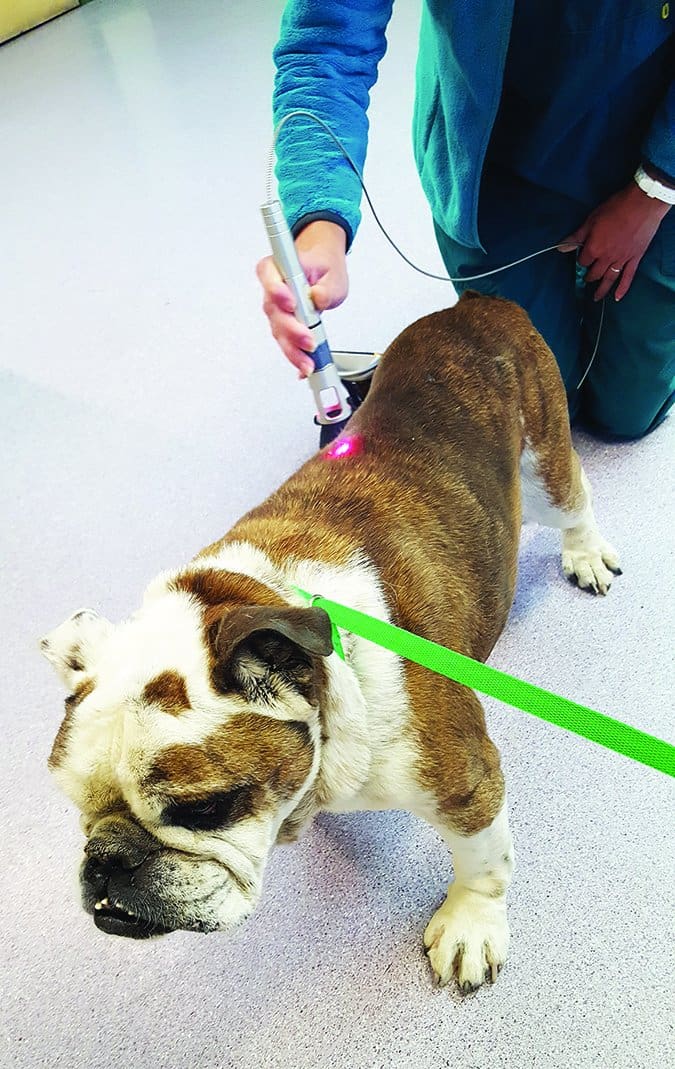ALTERNATIVE PAIN MANAGEMENT FOR ARTHRITIS: OVERVIEW
1. If your dog has chronic arthritis pain – especially if he’s relatively young for such troubles – consider exploring some of these alternative options.
2. Look for a veterinary practitioner who is open to alternative technologies. Many have developed a preference for a certain tool, based on good results with previous clients.
Arthritis pain, which affects four out of five older dogs, interferes with everything that makes life special for our best friends. Wouldn’t it be great if we could turn the clock back?
Technology may not yet offer a time machine, but it can seem that way for dogs treated with modern therapies that make them feel like puppies again. Would laser treatments, shock wave therapy, Pulsed Electromagnetic Frequency therapy, or other innovative treatments help your dog jump onto the sofa or run and play the way she used to?
Veterinary Lasers
Once exotic, laser treatments have gone mainstream with equipment that is increasingly safe and effective, so that thousands of veterinary clinics treat dogs, cats, horses, and other animals with lasers for a variety of conditions.

The term “laser” was originally an acronym for Light Amplification of Stimulated Emission of Radiation. First developed in the 1960s, lasers are used in fiber optics, computers, military weapons systems, manufacturing, building construction, communications, and medicine.
Laser beams are monochromatic (existing within a narrow band of wavelengths), coherent (tightly aligned), and collimated (with photons traveling in parallel). Lasers vary according to wavelength and power, and some lasers emit pulsing rather than continuous light waves. Power is measured in joules, an electrical energy classification.
Laser equipment varies according to the energy a laser emits (measured in joules); the time it takes the energy to reach target tissue (which determines the length of the treatment); wavelength (the laser’s depth of penetration, with blue light superficial, red light deeper, and nonvisible light deeper still); frequency (the number of impulses emitted per second); power (watts, the rate at which the energy is delivered); emission mode (continuous or pulsing); and dosage (joules per square centimeter, or J/cm2).
Class 1 and 2 lasers, which include laser pointers, are generally considered safe but have limited therapeutic use. Class 3 lasers (type 3A emits visible light and type 3B emits nonvisible light) have some therapeutic uses. The most recent laser classification (Class 4), approved for medical use by the U.S. Food and Drug Administration (FDA) in 2005, is used in human and veterinary medicine to improve circulation, relax muscles, and reduce inflammation, pain, and swelling caused by injuries, surgery, or chronic conditions, such as arthritis.
LLLT, or Low Level Laser Therapy, is performed with “cold” or “soft” lasers, which penetrate the skin’s surface with minimal heating. According to the research group ColdLasers.org, which describes over 40 therapeutic lasers, some class 4 cold lasers will warm the treatment area but are not considered hot lasers because they cannot cut or cauterize tissue.
The plethora of technical terms and conflicting claims can confuse clients and veterinarians alike. In a February 2016 report in the journal Vetted, Jennifer L. Wardlaw, DVM, asked, “Should your veterinary practice become laser-focused?” She recommended comparing the wavelength, power density, and pulse modulation of lasers, not just their cost. “For example,” she wrote, “if you get a weak laser with a small diode, it may take 45 minutes to treat a 5-centimeter surgical incision with the correct dosage of 4 to 6 J/cm2. But if you get a more powerful laser with a bigger diode, it may only take you five minutes to treat the same patient.”
Dr. Wardlaw recommends starting canine arthritis treatments with 6 to 8 J/cm2 every other day for two weeks. For wound healing she prescribes 8 J/cm2 once per day for seven days, and for tendonitis 6 J/cm2 every other day for two weeks. A hand-held wand delivers the treatment (goggles or sunglasses protect the eyes of practitioners and patients) and the dosage can be applied with a sweeping motion or by using back-and-forth movements as though following a grid while treating one small area at a time.
In 2011, clinicians at the University of Florida’s Small Animal Hospital compared 17 dogs with intervertebral disc disease treated postoperatively with lasers to 17 dogs not treated with lasers. All of the dogs (mostly Dachshunds, a breed associated with intervertebral disc disease) were unable to walk, and their diagnoses were confirmed through MRI or CT scanning. All underwent decompressive surgery after their diagnoses.
Thomas Schubert, DVM, and William Draper, DVM, treated half of the study’s 34 dogs with Thor Photomedicine’s Class 3B laser (thorvetlaser.com) in the near-infrared range, a wavelength that has been shown to speed the healing of muscle pain and superficial wounds in humans. They presented their findings at the American College of Veterinary Internal Medicine’s 2011 meeting in Denver, calling the results “amazing” because the laser-treated patients walked sooner, avoided medical complications, were less stressed, and reduced their recovery expenses due to less hospitalization time.
Success with Laser Treatment on Dogs
Tia Nelson, DVM, at Valley Veterinary Hospital in Helena, Montana, has used the K-Laser, a popular Class 4 device, to treat more than a hundred dogs for pain and wound healing. “The initial protocol is six treatments over three weeks,” she explains, “typically three the first week, two the second, and one the third, then as needed after that, usually once a month. The results vary, depending on the condition’s severity, location, and cause along with the dog’s age and activity levels, but most dogs seem to be more comfortable for many weeks after the initial treatments and some don’t need additional therapy.”
Dr. Nelson keeps track of her clients’ anecdotal reports. “Typically, we hear about dogs now being able to scramble happily up and down the stairs,” she says, “and generally being more active and engaged with their families.”
One of Dr. Nelson’s favorite patients is a Pomeranian who stopped jumping on the bed to sleep with her owner due to lower back arthritis. “Pain meds weren’t helping,” she says, “and joint-protecting supplements offered minimal relief. The owner was somewhat skeptical but agreed to try the K-Laser treatments. She called me almost in tears of joy after the first week’s treatments because her little girl was able to jump up on the bed!”
The website of the American Holistic Veterinary Medical Association lists 280 member veterinarians who provide laser therapy, and more can be found with simple online searches.
Lasers Designed for Home Use?
There are no clinical trials in the medical literature testing lasers designed for home use, but if you look for them, you can find people who have bought portable low-level lasers and who report good results on themselves and on their pets. You can find portable Low Level Laser Therapy equipment ranging in price from $119 to $299, as well as units that are more expensive, on sites such as Amazon.
Some lasers that are used for pain relief are marketed as beauty products for wrinkle reduction and other cosmetic effects because their distributors cannot promote them as medical devices. Customer support, refund policies, and product warranties vary, so check with manufacturers for details, and take online customer reviews with a grain of salt.
One might take comfort from marketing claims that products are “FDA cleared,” “FDA approved,” or “FDA registered.” Please note, however, that these are not official endorsements. A manufacturer registered with the FDA has completed an application informing the FDA of its products and is thus “FDA registered.” A medical device that is “FDA cleared” is “substantially equivalent” to a device already on the market. “FDA approval” means only that the FDA has reviewed the manufacturer’s testing results and has concluded that the benefits of the product outweigh its risks.
At Muller Veterinary Hospital’s Canine Rehabilitation Center in Walnut Creek, California, Erin Troy, DVM, has worked with canine patients who did not appear to benefit from home laser devices. “But they did respond when treated with Low Level Laser Therapy using a proven effective laser used by someone knowledgeable about what settings to use and where to treat,” she says. “I’m frustrated with home devices because there is much more to laser therapy than point-and-push-the-button.”
These are early days in veterinary laser treatments, and the few articles published about them in the medical literature caution that more blinded, placebo-controlled clinical trials are needed before the use of lasers is routinely advocated, especially for conditions other than pain, inflammation, and wound healing. If you are considering the purchase of a Low Level Laser for using on your dog at home, we’d suggest finding a veterinarian who uses and is knowledgeable about lasers, and who will show you how best to select and use a therapeutic laser at home.
Red Light Therapy for Arthritis Treatment
Also known as photonic therapy, low-intensity light therapy, LED therapy, photobiostimulation, photobiomodulation, and photorejuvenation, the application of red light by means of a hand-held device, stationary panels containing LED lights, or units designed for treatment from a distance or in direct contact with the skin all claim to reduce inflammation and arthritis pain in pets and people. You can find a dozen or more different models online.
Red light therapy uses wavelengths of light between 620 nm and 700 nm, with the most popular wavelengths used in in-home products between 630 nm and 660 nm. Some devices include multiple wavelengths.
The most popular red light device may be the $270 Tendlite, which resembles a slender flashlight powered by a rechargeable battery that emits red light at 660 nm. The Tendlite is held 1 inch from the area to be treated for 1 minute at a time. (Most red light therapy devices require longer treatment times.)
For additional information about red light therapy and red light devices, see Red Light Therapy Guide, Red Light Man, and Photonic Health, which focuses on red light therapy for dogs, cats, and other animals.
Shock Wave Therapy
It sounds electric, but shock wave therapy is actually the application of high-energy sound waves to specific parts of the body, such as to break up kidney stones and gallstones without the need for invasive surgery. For 25 years, ESWT (Extracorporeal Shock Wave Therapy, which refers to the waves’ generation outside the body) has been used to treat orthopedic conditions and joint pain in humans, horses, and dogs.
The canine conditions shown to improve with ESWT include osteoarthritis, hip and elbow dysplasia, chronic back pain, osteochondrosis lesions, sesamoiditis (degeneration of small bones in the foot that causes persistent lameness, especially in racing Greyhounds and Rottweilers), tendon injuries, lick granulomas, cruciate ligament injuries, nonunion or delayed-healing bone fractures, and painful scar tissue.
Shock wave therapy for dogs can have impressive results. Straus was contacted by New Jersey resident Debbie Efron when her veterinarian, Charles Schenck, DVM, a past president of the American Holistic Veterinary Medical Association, recommended shock wave therapy for Taylor, Efron’s 12-year-old Labrador Retriever, who had arthritis in her hips, spinal column, and right hock, and who had just torn a ligament in her right knee. Efron had never heard of shock wave therapy and asked for Straus’s opinion.
Encouraged by the positive results Straus found in the medical literature, Efron scheduled the procedure. Dr. Schenck treated Taylor’s hips, hock, and knee in two sessions, three to four weeks apart. He did not recommend shock wave therapy for the spine; he felt it works better where there is more soft tissue, so he continued treating the spine with acupuncture. Dr. Schenck hoped that eventually Taylor would experience an 80 percent improvement lasting six to seven months.

Just a few days after the first treatment, Efron told Straus, “Taylor is greeting me at the door with a toy in her mouth, something she stopped doing weeks ago. She is eager to go for walks and pulls me around the block with no limping and her back legs no longer buckle. She is playful again, wanting to wrestle and play.”
Eight months after treatment, Efron sent an update: “Taylor is on no medications, but she gets a lot of supplements and a raw diet. I think her improvement peaked about eight weeks after the second treatment, and she’s been great on walks ever since.”
As Kristin Kirkby, DVM, wrote in “Shock Wave Therapy as a Treatment Option” in the August 2013 Clinician’s Brief, “Shock waves can be generated in many ways, but electrohydraulic devices have the greatest capacity to produce and project high energy to a deep focal depth. ESWT can be highly focused and can achieve a focal point beyond 10 centimeters into deeper tissues, depending on the treatment head used. ESWT differs from radial pressure wave therapy, which does not deliver focused energy at the target; instead, acoustic waves spread eccentrically from the applicator tip.”
According to Dr. Kirkby, shock wave therapy has been shown to modulate the osteoarthritic disease process in animal models. Several studies have demonstrated positive results in joint range of motion and peak vertical force – as measured using force plate analysis – in dogs with stifle, hip, and elbow arthritis. For example, in dogs with unilateral elbow osteoarthritis treated with ESWT, improvement in lameness and peak vertical force was equivalent to that expected with nonsteroidal anti-inflammatory drugs.
A dog may be shaved to reduce interference between the probe and the dog’s skin, and a gel is applied to improve transmission. Treatment time depends on the amount of energy delivered and number of locations treated. A common dose of 800 pulses per joint requires fewer than 4 minutes to deliver.
The first shock wave generators were expensive, bulky, noisy, and painful, but the technology keeps improving. The new PiezoWave2 Vet Unit uses piezoelectric crystals to produce high-pressure sound waves and it has made ESWT machinery smaller, more affordable, and more accessible for large and small animals to receive treatment without sedation. TRT’s VetGold device is now also smaller and almost pain-free, no anesthesia required.
The makers of the VersaTron 4 Paws and the newer, smaller ProPulse shock wave devices publish case studies online, including reports of arthritic inflammatory disease, shoulder and elbow arthritis, and lumbar spondylosis in Labrador Retrievers and other dogs. In several cases, a variety of conventional and alternative therapies had been tried with minimal success, and the dogs were in severe chronic pain. In some cases lameness increased after the first treatment, but most dogs experienced significant improvement within a week.
Because shock wave therapy does not cure or reverse arthritis, its relief of symptoms may diminish after several months or a year, at which time a repeat treatment may be needed.
Ultrasound Therapy for Pain Reduction
Best known as a diagnostic tool or a means of determining an unborn baby’s sex, ultrasound has been used by physical therapists since the 1940s to alleviate pain and inflammation. Sound waves generated by a piezoelectric effect caused by the vibration of crystals in the head of a wand or probe pass through the skin and vibrate adjacent tissues.
In addition to having a warming effect, ultrasound has been shown to increase tissue relaxation, local blood flow, and scar tissue breakdown. Conditions treated with ultrasound include tendonitis, joint swelling, and muscle spasms. The treatment is not recommended on or around malignant tumors or metal implants.
In March 2008, a critical review of published research on the effects of ultrasound in the treatment and management of osteoarthritis in humans appeared in the Journal of the Canadian Chiropractic Association. Seventeen articles met the researchers’ criteria for methodology and accurate reporting; most of them showed that ultrasound, in addition to being cost-effective, portable, and easy to use, has significant therapeutic benefits.
For information about veterinary ultrasound therapy and referrals to veterinarians who treat dogs for arthritis and other conditions with this approach, contact the American Association of Rehabilitation Veterinarians or the Canine Rehabilitation Institute, or simply search online for veterinary ultrasound therapy.
Pulsed Electromagnetic Field Therapy (PEMF)
Magnets have long been thought to have healing properties, and whole industries have been created around the alleged benefits of magnetic jewelry, massage tools, mattress pads, and other devices. Do they work? A lack of research on the application of magnets to human or canine illnesses or injuries makes it hard to know.
But when it comes to pulsed electromagnetic field therapy, or PEMF, the evidence is growing. For many years electromagnetic field therapy was widely used in Europe while its use in the United States was restricted to animals. Veterinarians treating racehorses for broken bones were the first American health professionals to use PEMF. Now thousands of human clinical trials have shown beneficial results from PEMF therapy for chronic low back pain, fibromyalgia, cervical osteoarthritis, osteoarthritis of the knee, lateral epicondylitis, recovery from arthroscopic knee surgery, recovery from interbody lumbar fusions, persistent rotator cuff tendonitis, and other conditions.
The first PEMF device was a coil that generated a magnetic field into which the patient’s body was placed to deliver treatment. Most of today’s PEMF devices are mats similar to thick yoga mats containing flat spiral coils that produce an even electromagnetic field, or they consist of rings or coils that are placed on or under the person or animal being treated, or they are flat, circular magnets that can be placed under a mattress. An electric-frequency generator energizes the coils to create a “pulsed” electromagnetic field.
Comparing PEMF devices by their technical specifications requires a crash course in frequency, amplitude, intensity, sine waves, sawtooth wave forms, Schumann resonance frequencies, and other terms – and even the technically informed disagree as to which combinations are best for human, canine, and equine health. Intensity is measured in Tesla units (µT) and frequency is measured in Herz units (Hz). Those who compare PEMF systems usually recommend staying close to the earth’s magnetic field frequencies (11.75 and 11.79 Hz, or in the 0 to 30 Hz range) and low intensity (1 to 20 microtesla, which is less than the earth’s 30-66 microtesla).
Most of the websites mentioned here provide technical information and reports that help users understand the basics.
PEMF devices can be used for acute and chronic conditions, and there are no known adverse side effects, potential drug interactions, or interactions with surgical implants. The electromagnetic field penetrates clothing, fur, casts, and bandages to reach all tissue in the target area.
Acute inflammation often improves after one or two treatments, while chronic or degenerative symptoms may need two weeks or a month. In most cases, pain medications can be reduced or eliminated. (This should be done under medical supervision.)
Thanks to PEMF’s popularity in Europe, low-intensity, low-frequency, full-body PEMF mats are available in the United States. They are designed for humans but some users report improvements in dogs and cats recovering from accidents or illness, including arthritis in older animals. Pets often seek out and sleep on PEMF devices.
The best full-body mats are expensive, with the iMRS, which is made in Switzerland, starting at $3,600, and the Bemer, which is manufactured in Liechtenstein, starting at $4,300. Both can be rented by the month.
PEMF for Pets
In addition to full-body mats for people, the PEMF marketplace offers products specifically for dogs, cats, horses, and other animals. See the American Holistic Veterinary Medical Association website for veterinarians who provide pulsating magnet therapy.
Originally designed for human use, the Assisi Loop is sold by Assisi Animal Health for use with pets. According to its manufacturer, “The Assisi Loop generates a twice-per-second 2-millisecond burst of a 27.12 Megahertz radio wave signal with an amplitude of 4 microtesla. This pulse-modulated field is non-thermal and non-invasive, yet is sufficient in strength to have therapeutic benefit.”

The Loop’s electromagnetic field extends 4 to 5 inches on either side of the coil. The Assisi Loop website explains, “By emitting a burst of micro current electricity, a field is created which evenly penetrates both soft and hard body tissue around the target area. This electromagnetic field causes a chemical cascade, which activates the well-known nitric oxide cycle. Nitric oxide is a key molecule in healing for humans and animals. The compound is released when we exercise, and when we are injured, for the body to naturally repair itself.”
The Assisi Loop comes in two sizes, 7.5 inches (20 centimeters) or 4 inches (10 cm). The smaller loop is convenient for treating extremities, small animals, or conditions that are focused in an area less than 4 inches in diameter. For chronic or degenerative conditions like arthritis, the manufacturer recommends giving dogs three or four 15-minute treatments per day for a week to 10 days, monitoring until you see improved mobility and less pain response. You can then taper down to one or two treatments per day or even one to three treatments per week, and over time the patient may be treated only as needed for pain.
Both sizes of the Assisi Loop offer a minimum of 150 15-minute treatments and the Assisi Loop 2.0 Auto-Cycle offers a minimum of 100 15-minute treatments. The life of the Loop depends on its battery, which, because of FDA regulations, cannot be recharged or replaced. One Assisi Loop typically lasts from three weeks to six months, depending on the condition being treated and the number of treatments required per day.
The Assisi Loop can be purchased ($280) from veterinarians and animal rehabilitation facilities or directly from Assisi Animal Health with a prescription from your veterinarian.
Magna Wave sells several professional PEMF devices for between $7,000 and $21,000, plus a Magna Wave LP (Low Power) model, which is recommended for bone and soft-tissue injuries, for $429. According to its manufacturer, the Magna Wave LP incorporates Inductively Coupled Electrical Stimulation (ICES) technology that penetrates beneath the skin’s surface and zeros in on affected deep-tissue areas. Magna Wave provides PEMF training, practitioner certification, and technical/business support for veterinarians and other health care professionals.
EarthPulse PEMF consists of a circular magnet that goes under your (or your dog’s) mattress, by itself or in combination with a second magnet. The magnets plug into a simple control unit and can be left running without supervision for up to 12 hours. Its adjustable amplitude settings, recovery mode, and sleep programs make the EarthPulse a versatile, portable, “set it and forget it” PEMF device. Its five systems range in price from $499 for the basic single-magnet model to $1,799 for the four-magnet battery operated unit recommended for horses.
The Bio-Pulse Dog Therapy System consists of a large (for dogs over 50 pounds) or small (up to 50 pounds) mat with magnetic coils mounted on soft foam. “The depth of field of Respond Systems Bio-Pulse PEMF Therapy System can penetrate through the entire body of a dog lying on the bed reaching deep into the joints and muscles, stimulating circulation,” explains the website. “The system can be placed on the couch, in a crate, under your animal’s bedding or even in the car.” Prices range from $599 to $899.
The only PEMF system that’s designed to be worn by dogs is Brandenburg Equine Therapy‘s SI (Sports Innovations) Canine PEMF Therapy Blanket. It comes in three sizes (small, medium, and large) and is recommended for recovery, pain management, increased circulation, vitalization, and general relaxation. Another option is the PEMF dog mat, which can be placed on any sleeping surface. The therapy blankets and mats, which are made in Germany, cost $1,650 each and can be rented.
The Amethyst BioMat
Who wouldn’t want to rest on a bed of amethyst crystals? Add gentle heat produced by far infrared technology and the relaxing benefits of negative ions, and you have a spa experience – one that your dog can enjoy, too.
BioMats, manufactured in South Korea where the technology is popular and well researched, are known for their anti-inflammatory effects, providing relief from sprains, strains, muscle and joint pain, stiffness, stress, and fatigue. BioMats come in several sizes, starting with the BioMat Mini (17 by 33 inches, 8 pounds, $670 plus $40 shipping). The mat is sewn with channels containing alternating rows of amethyst and tourmaline crystals, known among crystal enthusiasts for their healing properties.
For years I kept a BioMat Mini on our sofa, turned to the lowest heat setting. Chloe, my Labrador Retriever, ignored it because she preferred to sleep with her head on a frozen water bottle. But with age, her preferences changed, and by her 10th birthday, Chloe was spending a few hours every day stretched out on the sofa. Many BioMat users report that, like Chloe, their dogs went from stiff and sore to more relaxed and mobile soon after they started resting on the mat.

Creature Comforts
As our dogs age, we do everything we can to make them comfortable. In addition to nutrition, exercise, weight management, natural and prescription pain medications, aromatherapy, medicinal herbs, and assistive devices, today’s technologies may provide the support that will make a difference for your older dog.
Montana resident CJ Puotinen is the author of The Encyclopedia of Natural Pet Care and other books.







My sister has a bunch of dogs and one is getting pretty old and is starting to develop arthritis. She really wants to make sure that he is comfortable and is doing the best he can. I’ll be sure to tell her that Red-light therapy is between 620 nm and 700nm and can help her dog.
It’s amazing that in the research done, the majority of the dogs felt better after their treatments and that laser therapy can help reduce their pain. My golden retriever, Monty, is getting older and has arthritis. I think I’ll look into finding a veterinary exam that can help give him this treatment to help him feel more comfortable.
Thanks so very much for the explanations of different treatment available at home for dogs with arthritis pain. I was particularly interested in the info on The PEMF- Assisi Loop. My Chiropractor Vet used it on one of my dogs and it didn’t seem to do him any good. Next I took in his Mom and didn’t see much benefit of it either the 1st time. The Vet said to me like you stated form the website of the Mfg., that it needs to be done very frequent initially, then it can be tapered when results are achieved. I have had my dogs treat with the Laser and the did well on that. I also see that the Assisi Co. has a PEMF for Thunderstorm Fearful dogs,NOW that really sounds promising!!